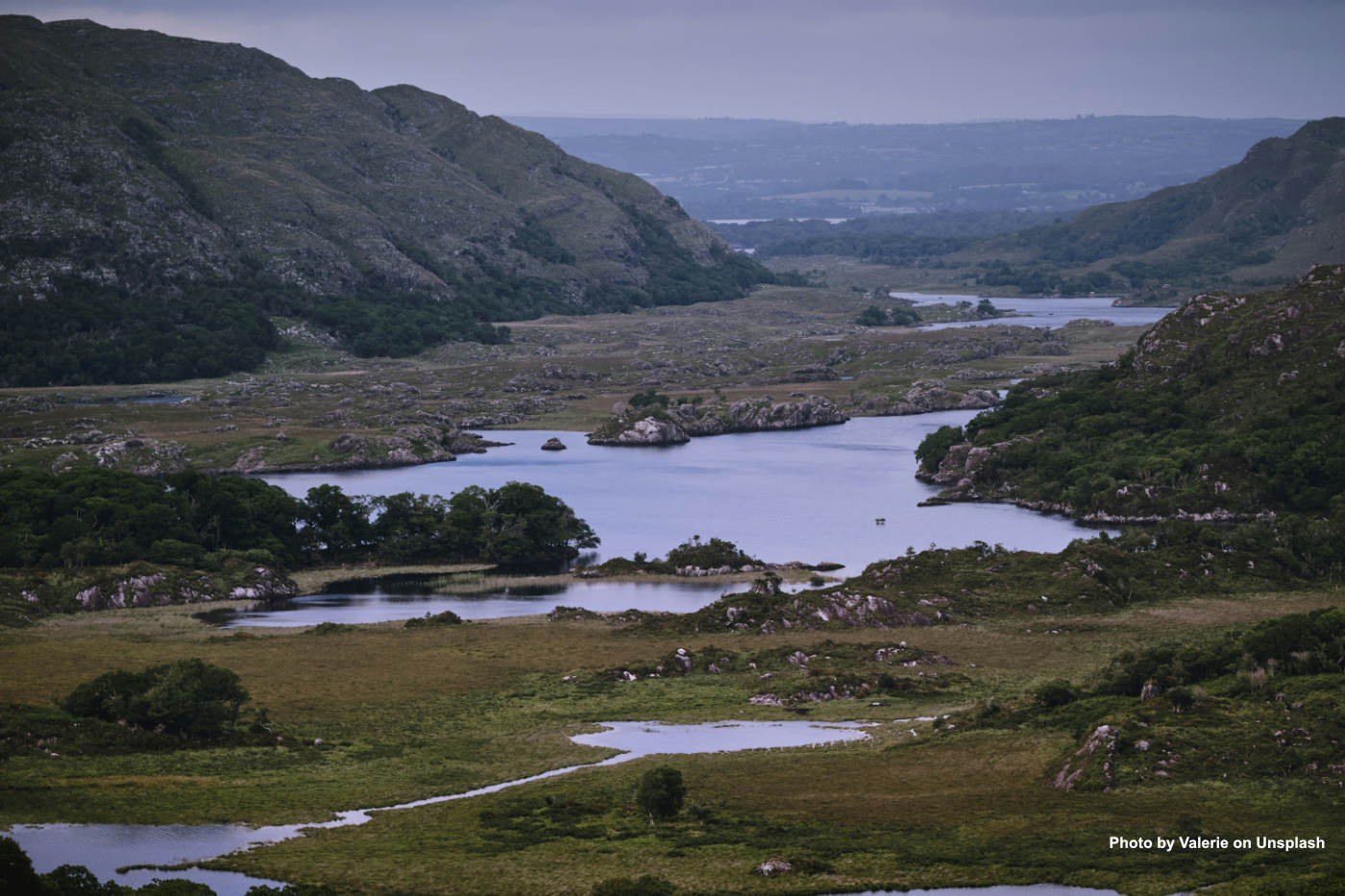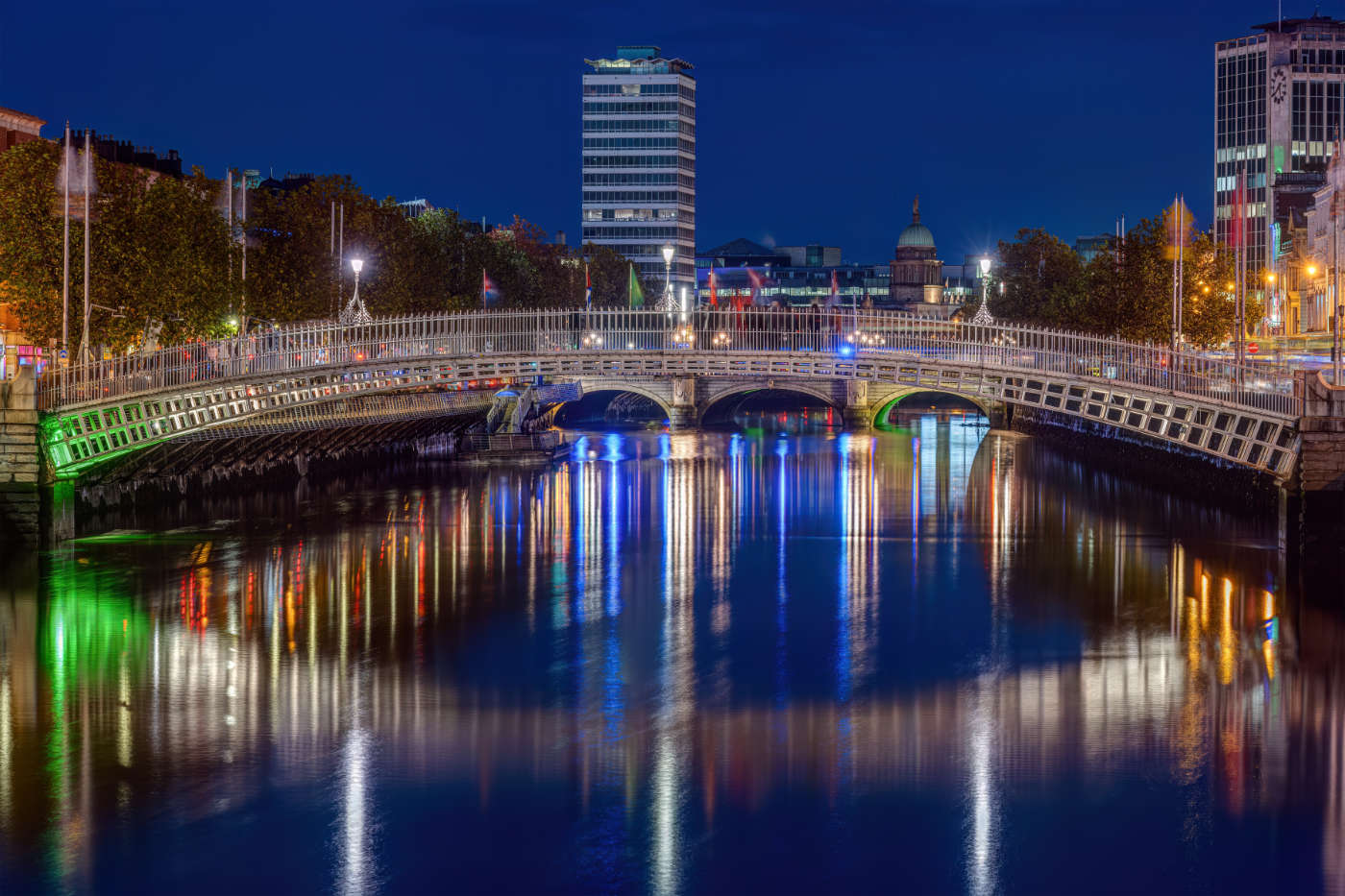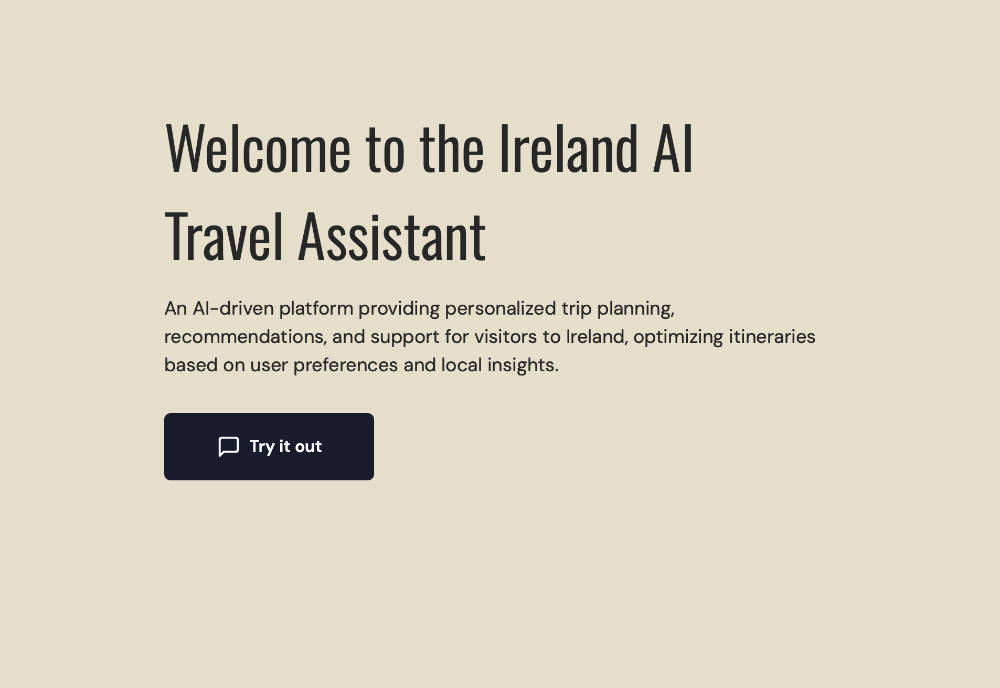Road Trip Ireland 3 Days
Looking for the perfect road trip Ireland 3 days itinerary? Start in Shannon and discover Ireland’s rugged beauty, vibrant towns, and iconic landmarks—all in just three unforgettable days.
Three Days in Ireland
Discover how to make the most of three days in Ireland with this unforgettable Northern itinerary, packed with history, natural wonders, and cultural gems!
3 Days in Dublin
Got 3 days in Dublin? Get ready for a whirlwind adventure through history, culture, and the buzzing heart of Ireland’s capital!
3 Days in Ireland: Short Stay Unforgettable Experiences
Planning a short trip to Ireland? This 3 Days in Ireland guide offers a concise itinerary to help you experience the country’s highlights efficiently. For a more detailed plan, check out our 3 Day Ireland Itinerary, which provides in-depth insights and tips to enhance your journey. Both resources are part of our comprehensive Ireland Itinerary Hub, designed to assist you in crafting the perfect Irish adventure.
Preparing for Your 3 Day Trip to Ireland
A well-prepared traveler enjoys a smoother and more enjoyable trip. Here’s how to set yourself up for success:
Best Time to Visit
Ireland’s seasons each bring their own charm, but the best time to visit for a 3-day trip is typically spring (April-May) or autumn (September-October). These months strike the perfect balance with mild weather, fewer tourists, and stunning natural landscapes. Spring brings blooming wildflowers, while autumn offers golden foliage, creating ideal conditions for scenic drives and outdoor adventures.
Summer is another popular choice due to longer daylight hours and festivals, but it comes with higher prices and more crowds, especially in tourist hotspots like Dublin and the Cliffs of Moher. If you’re visiting in summer, booking accommodations and attractions well in advance is essential.
Winter, though cold and often rainy, has its own cozy appeal. With fewer crowds, you can enjoy peaceful walks, roaring fires in traditional pubs, and festive holiday markets in December. However, shorter daylight hours mean planning activities wisely is a must. Choosing the best time to visit is crucial for maximizing your 3 days in Ireland.
Flights and Airports
Dublin Airport serves as the primary gateway for most international travelers and offers excellent connections to major cities around the world. It’s a bustling hub with convenient facilities, making it a great starting point for your trip. From here, you can easily access Dublin’s city center via taxis, buses, or the Aircoach service.
Shannon Airport, located in western Ireland, is a fantastic alternative if you plan to focus on the Wild Atlantic Way or the Cliffs of Moher. It’s smaller and less crowded, allowing for a more relaxed arrival experience. This airport is particularly convenient for those flying from North America, as it often offers direct flights.
Efficient flight planning ensures you spend more time exploring during your 3 days in Ireland. Consider flying mid-week for cheaper fares, and if your schedule allows, be flexible with your travel dates. Tools like flight comparison websites can help you find the best deals and routes.
Packing Essentials
Ireland’s famously unpredictable weather means that smart packing is key. Layers are your best friend, as mornings can be chilly, afternoons mild, and evenings rainy. A waterproof jacket is non-negotiable, especially for coastal or countryside visits, where sudden downpours are common.
Footwear is equally important. Sturdy walking shoes or boots are ideal for exploring cobbled city streets, ancient ruins, or the rugged terrain of places like the Burren. A comfortable yet stylish pair of shoes is a great addition for indoor activities or dining.
Remember practical items such as a universal travel adapter for electronics, a reusable water bottle to stay hydrated, and a small daypack for carrying snacks, cameras, or souvenirs. A power bank for charging devices on the go can also be incredibly handy. Packing smartly enhances your comfort throughout your 3 days in Ireland.
Transportation Choices
Selecting the right transportation is key to navigating Ireland efficiently during your 3 days in Ireland. Renting a car is often the best option for those looking to explore rural areas like the Wicklow Mountains or Connemara. It provides maximum flexibility and access to hidden gems not served by public transport. However, remember that driving is on the left side of the road in Ireland, and country roads can be narrow and winding.
Public transport is a reliable and budget-friendly alternative for city-to-city travel. Trains operated by Irish Rail connect major cities like Dublin, Cork, and Galway, while buses, such as those run by Bus Éireann, provide access to smaller towns and villages. Pre-booking your tickets can save both time and money.
Walking tours or cycling rentals are fantastic options for city exploration. Dublin and Galway, in particular, are compact and pedestrian-friendly, allowing you to immerse yourself in their vibrant atmospheres without the need for a car.
Setting Realistic Expectations
Understanding what’s feasible helps you set realistic expectations for your 3 days in Ireland. Three days may seem like a short time, but it’s enough to experience the essence of Ireland with a focused itinerary. Prioritize a mix of city, countryside, and coastal experiences to get a well-rounded taste of the country. For example, dedicating one day each to Dublin, the countryside, and the Wild Atlantic Way ensures you see diverse aspects of Ireland.
Overloading your schedule can lead to stress and exhaustion. Instead, leave room for unplanned moments, such as stumbling upon a charming café or striking up a conversation with locals in a pub. These spontaneous experiences often become the most memorable.
The AI Ireland Travel Expert is an invaluable tool for short trips. It helps you identify must-see attractions, optimize travel routes, and save time by streamlining your plans. With its assistance, you can make the most of every hour in Ireland without feeling overwhelmed.
Must-Have Experiences for 3 Days in Ireland
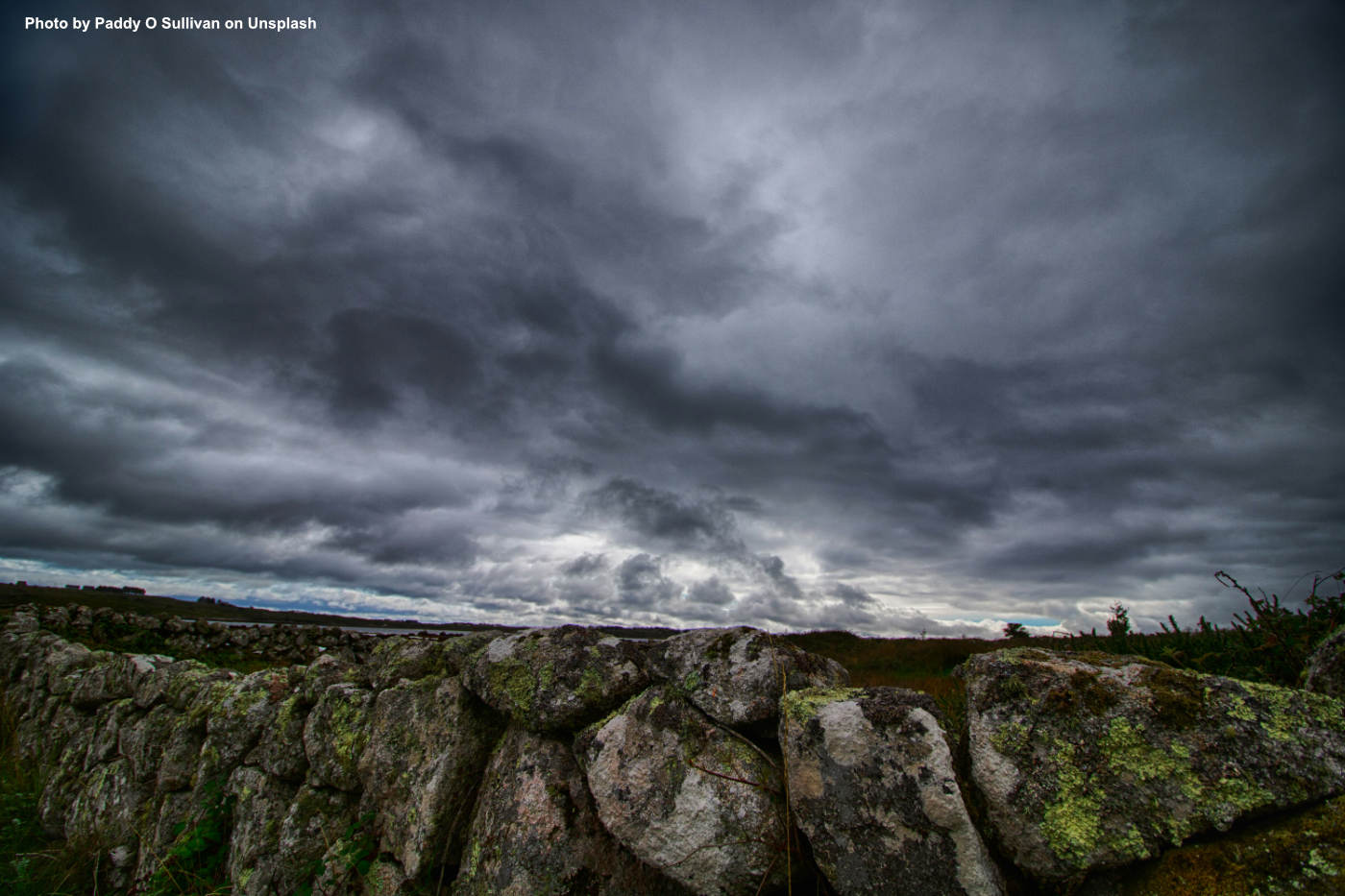
Ireland is a country brimming with unique experiences, and while three days aren’t enough to see everything, you can still immerse yourself in some of its most iconic offerings. To make your 3 days in Ireland unforgettable, prioritize these must-have experiences:
Iconic Landmarks
Visiting iconic landmarks is a highlight of any 3 days in Ireland itinerary. A trip to Ireland would only be complete with visiting its famous landmarks. The Cliffs of Moher are an absolute must-see, rising dramatically from the Atlantic Ocean and offering breathtaking views that seem to stretch forever. Whether you hike along the cliff trails or visit the interactive visitor center, this natural wonder will leave a lasting impression.
Another unmissable destination is Blarney Castle, home to the legendary Blarney Stone. Kissing the stone is said to grant the gift of eloquence, and the castle itself is surrounded by enchanting gardens that are a joy to explore. If time permits, add a scenic drive around the Ring of Kerry, a stunning route that showcases Ireland’s lush greenery, rugged coastlines, and quaint villages.
For history lovers, don’t miss Trinity College in Dublin, where you can marvel at the Book of Kells, an illuminated manuscript that’s over 1,000 years old. The Rock of Cashel, a historic site perched on a hill, is another must-visit for its medieval architecture and panoramic views of the surrounding countryside.
Traditional Music and Pubs
Ireland’s traditional music scene is an experience in itself. Pubs are the heartbeat of Irish culture, offering not just a place to enjoy a pint but also a venue for spontaneous musical sessions known as seisiúns. In cities like Dublin, the lively atmosphere of Temple Bar is perfect for newcomers to Irish music, with its mix of tourists and locals enjoying fiddle tunes, bodhrán beats, and lively jigs.
For a more intimate experience, head to Galway’s Latin Quarter, where smaller, cozy pubs like Tigh Neachtain or The Crane Bar host nightly performances. The authenticity of these settings allows you to truly feel the warmth of Ireland’s community spirit. Whether you’re tapping your feet to a jig or singing along to a classic ballad, the music brings everyone together.
Pubs aren’t just for drinking—they’re also fantastic places to savor local dishes. Order a plate of Irish stew or seafood chowder alongside your pint of Guinness, and you’ll get a true taste of Ireland’s culinary heritage. These simple, hearty meals pair perfectly with the lively ambiance of a traditional pub.
Historic Castles and Ruins
Exploring historic castles adds depth to your 3 days in Ireland. Kilkenny Castle, with its manicured gardens and imposing stone towers, offers a glimpse into medieval life. Guided tours reveal fascinating stories of noble families and architectural evolution, making it a perfect stop for history enthusiasts.
The Monastic City of Glendalough, nestled in the Wicklow Mountains, transports you back to early Christian Ireland. Surrounded by serene lakes and lush greenery, this site includes ancient round towers, churches, and stone crosses. It’s a peaceful place to wander and reflect on Ireland’s spiritual history.
For those interested in archaeology, the Burren in County Clare offers an otherworldly landscape filled with prehistoric sites. From dolmens (megalithic tombs) to Celtic stone forts, this region showcases Ireland’s ancient past in a way that’s both educational and awe-inspiring.
Sampling Irish Cuisine and Drinks
Savoring local cuisine is essential to fully experience your 3 days in Ireland. Start with traditional dishes like boxty (a potato pancake), coddle (a hearty stew), or bacon and cabbage, a favorite comfort food. Many restaurants now incorporate modern twists on these classics, reflecting Ireland’s evolving food culture.
Seafood lovers should head to the coast, where you’ll find fresh oysters, mussels, and salmon. Cities like Galway are known for their seafood festivals and farm-to-table restaurants, offering the freshest local ingredients. Don’t miss trying a bowl of creamy seafood chowder with brown soda bread—a true Irish staple.
Of course, every meal is complete with Ireland’s famous drinks. Beyond Guinness, explore the world of Irish whiskey with a distillery tour at Jameson in Dublin or Bushmills in Northern Ireland. For a unique twist, sample craft ciders and gins are gaining popularity among locals and visitors alike.
Shopping for Keepsakes
Collecting souvenirs creates lasting memories of your 3 days in Ireland. Ireland is renowned for its craftsmanship, making it a great place to shop for meaningful souvenirs. Aran sweaters, hand-knit from soft wool, are both stylish and functional, keeping you warm while reminding you of your trip. Look for these in local markets or specialty shops like The Sweater Shop in Dublin.
Jewelry enthusiasts will appreciate the symbolism of the Claddagh ring, a traditional Irish design representing love, loyalty, and friendship. Many jewelers offer custom engraving for a personal touch.
For something unique, pick up a piece of Irish pottery or glassware. Studios like Belleek Pottery or Waterford Crystal create stunning, handcrafted items that make wonderful gifts or keepsakes. Pair these with some Irish treats like whiskey-infused chocolates or artisan jams for the perfect souvenir of your trip.
Top Cities and Regions to Consider During 3 Days in Ireland
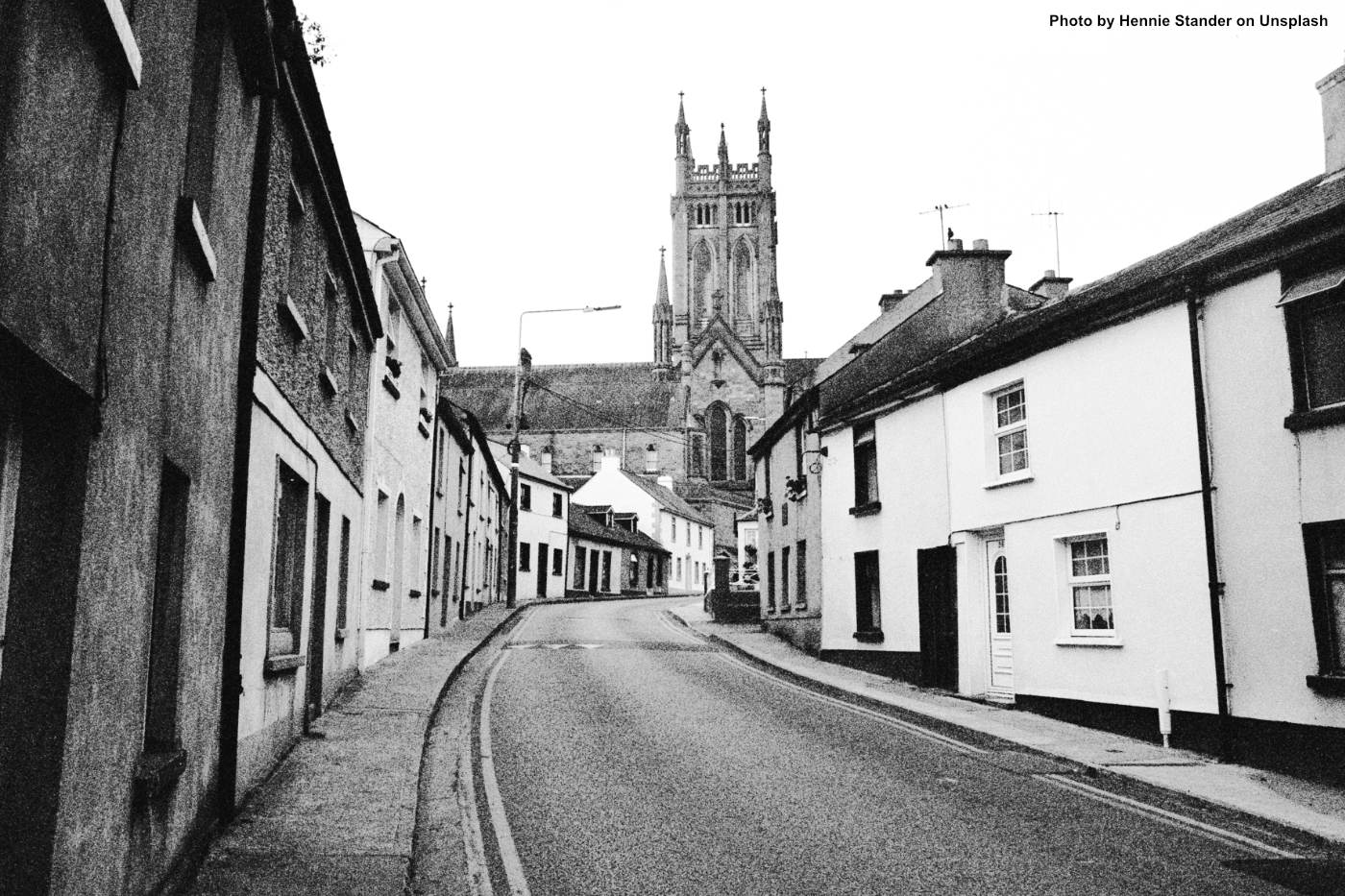
These cities and regions are perfect for your 3 days in Ireland. Ireland’s charm is spread across its cities and regions, each offering a unique flavor of the country’s history, culture, and natural beauty. For a 3-day trip, here are the top destinations to consider incorporating into your itinerary.
Dublin: Ireland’s Bustling Capital
Dublin offers a vibrant start to your 3 days in Ireland. The city is a vibrant blend of history and modernity. Walking through Dublin, you’ll encounter landmarks like Trinity College, Dublin Castle, and the historic Christ Church Cathedral, each telling a story of Ireland’s past.
For a taste of Dublin’s culture, visit the Temple Bar District, where cobbled streets are alive with traditional music, bustling pubs, and street performers. It’s the perfect place to unwind after a day of sightseeing. If you enjoy museums, the EPIC Irish Emigration Museum and Kilmainham Gaol are must-sees, offering insights into Ireland’s rich history.
Dublin also excels at dining and shopping. Explore Grafton Street for local boutiques, and don’t miss trying dishes like Irish stew or boxty in one of its many restaurants. Dublin’s energy makes it an unmissable highlight of any trip.
Galway: The Cultural Heart
Known for its lively arts scene and coastal beauty, Galway is a city full of character. Strolling through the Latin Quarter, you’ll find colorful shopfronts, quaint cafes, and a plethora of street performers adding to the city’s charm. Galway’s compact size makes it a joy to explore on foot, with hidden gems at every turn.
A visit to Galway Cathedral is a must, as its stunning architecture is both modern and traditional. For nature lovers, the Salthill Promenade offers breathtaking views of Galway Bay and is perfect for an evening walk or a relaxing coffee by the water.
The city also hosts several festivals throughout the year, including the Galway International Arts Festival, making it an excellent destination for those seeking cultural immersion. Whether you’re visiting the markets, enjoying fresh seafood, or sipping a pint in a lively pub, Galway delivers unforgettable experiences.
Cork: A Culinary Gem
Cork is Ireland’s second-largest city and is often referred to as the country’s food capital. Begin your exploration at the English Market, a historic food market brimming with local produce, artisan goods, and friendly vendors. Sampling treats here is a highlight for any foodie.
The city’s laid-back vibe is complemented by its many waterways, giving it a unique charm. Take a stroll along the River Lee or visit the iconic Shandon Bells at St. Anne’s Church, where you can ring the bells yourself while enjoying panoramic views of Cork.
A short drive from the city takes you to Blarney Castle, where you can kiss the famous Blarney Stone and wander through the stunning castle grounds. Whether it’s the culinary delights or historical landmarks, Cork offers a perfect mix for travelers.
Limerick: A Gateway to the West
Limerick, often overlooked by travelers, is a city with deep medieval roots and a growing modern appeal. Start with a visit to King John’s Castle, a fortress on the banks of the River Shannon, where you can explore interactive exhibits and enjoy sweeping views of the city.
The Hunt Museum is another gem, housing a collection of art and artifacts that span centuries. For a dose of culture, check out Limerick’s vibrant arts scene or catch a performance at the Lime Tree Theatre.
Beyond the city, Limerick serves as an excellent base for exploring the Wild Atlantic Way, including easy day trips to the Cliffs of Moher or the Burren. Its location and history make it a convenient and enriching stop for travelers.
Kilkenny: A Medieval Treasure
Kilkenny is a small city that punches above its weight in history and charm. The centerpiece is Kilkenny Castle, a magnificent structure surrounded by beautifully landscaped gardens. Guided tours of the castle provide insights into its history and the influential families who lived there.
For a more intimate historical experience, visit St. Canice’s Cathedral, where you can climb the round tower for incredible views. Kilkenny is also known for its arts and crafts scene, with several local shops and galleries showcasing handmade pottery, jewelry, and paintings.
Wandering Kilkenny’s medieval streets feels like stepping back in time. Its compact layout makes it easy to explore on foot, and its warm, welcoming vibe leaves a lasting impression on visitors.
Tips for Making the Most of Your 3 Days in Ireland
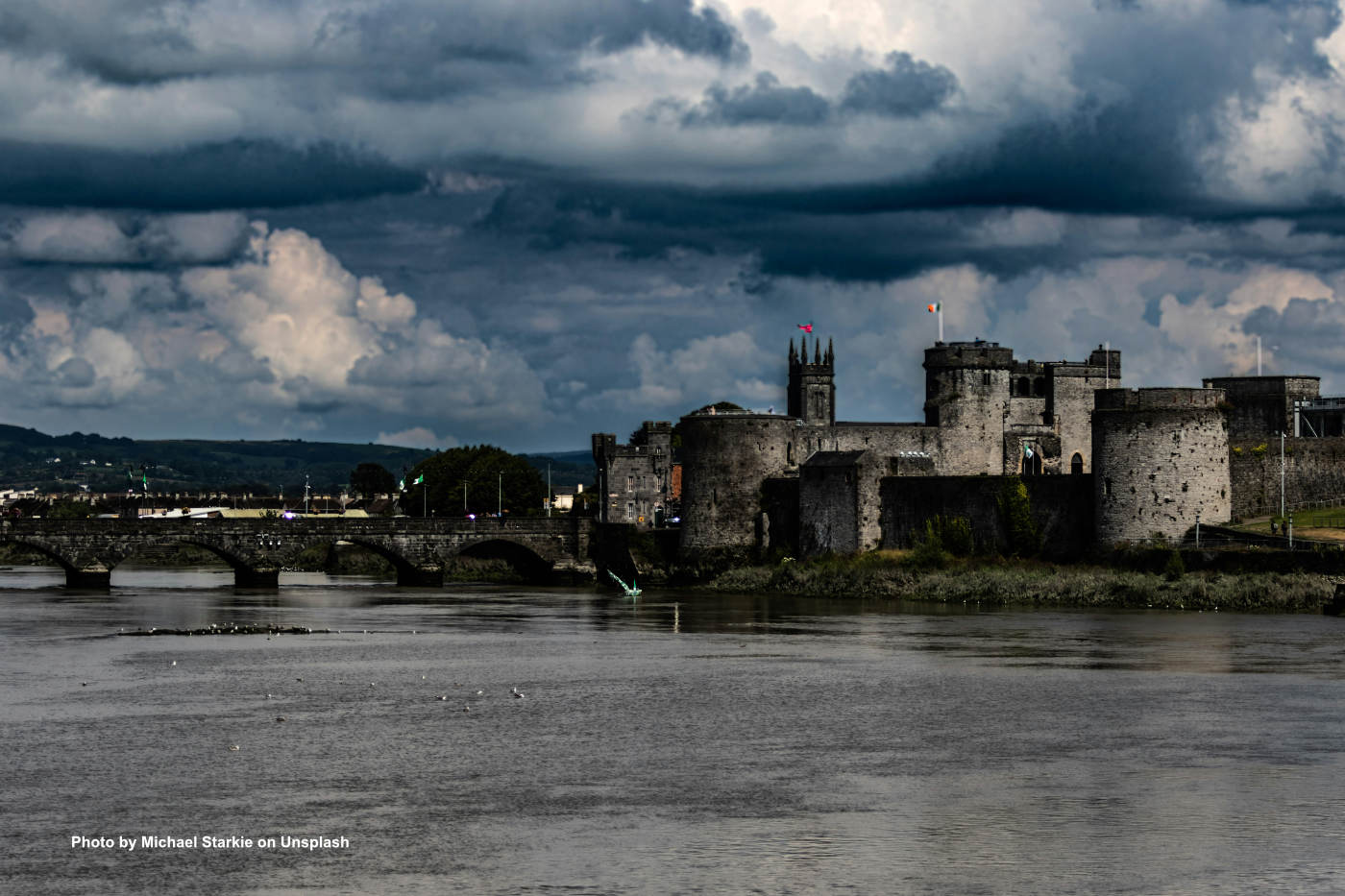
These tips will help you maximize your 3 days in Ireland. A 3-day trip to Ireland may seem short, but with careful planning and the right approach, you can enjoy an unforgettable adventure. Follow these tips to maximize your time and ensure a seamless journey.
Avoid Overpacking Your Schedule
It’s tempting to fit in as much as possible, but overloading your itinerary can leave you feeling rushed and exhausted. Instead, focus on a few key highlights each day to give yourself time to truly enjoy each experience. A balanced itinerary ensures a relaxed 3 days in Ireland. For instance, if you’re visiting Dublin, prioritize landmarks like Trinity College and the Guinness Storehouse, but leave room to relax in St. Stephen’s Green or a cozy café.
Allowing some flexibility in your schedule also creates space for unplanned discoveries. You might stumble upon a charming market, a lively street performance, or a quiet moment at a breathtaking viewpoint. These spontaneous experiences often become the most memorable parts of a trip.
The AI Ireland Itinerary Creator is an excellent tool for managing your time effectively. It can help you create a balanced itinerary, ensuring you hit all your must-sees without feeling overwhelmed.
Utilize Local Guides and Tour Operators
One of the best ways to learn about Ireland is through the stories of its people. Local guides bring depth to your visit with anecdotes, history, and insider knowledge you won’t find in guidebooks and this can only enhance your 3 days in Ireland.. Walking tours, such as those offered in Dublin or Galway, are a great way to explore cities while gaining fascinating insights.
For countryside adventures, consider joining a group tour to destinations like the Cliffs of Moher or the Ring of Kerry. These tours often include transportation, making it easier to access remote areas without the stress of navigating on your own. Plus, expert guides can point out hidden gems along the way.
Booking tours in advance is recommended, especially for popular attractions. Many tours also offer skip-the-line privileges, saving valuable time during your short trip.
Embrace Ireland’s Weather
Ireland’s weather is famously unpredictable, but it’s all part of the charm. Being prepared for the weather ensures comfort during your 3 days in Ireland. Layers are essential, as temperatures can vary throughout the day. Pack a waterproof jacket and sturdy shoes to handle rain or muddy trails, particularly if you’re exploring outdoor attractions like the Burren or Wicklow Mountains National Park.
Don’t let the weather deter you from enjoying Ireland’s beauty. A misty morning can add an enchanting atmosphere to places like the Cliffs of Moher, while a sudden burst of sunshine might reveal a stunning rainbow over rolling hills. Locals often say, “If you don’t like the weather, wait five minutes,” so embrace the unpredictability and pack with flexibility in mind.
Get Off the Beaten Path
While Ireland’s famous attractions are undeniably worth visiting, don’t hesitate to explore lesser-known spots for a more authentic experience. For example, instead of just sticking to Dublin’s Temple Bar, venture to neighborhoods like Stoneybatter, known for its trendy cafes and local vibe.
In the countryside, small villages such as Doolin in County Clare or Adare in County Limerick offer a slower pace and glimpses of traditional Irish life. Chatting with locals at a pub or visiting a family-run farm can give you a deeper connection to Ireland’s culture.
The AI Ireland Travel Expert can also recommend hidden gems tailored to your interests, ensuring your trip is unique and personalized.
Maximize Your Evenings
Evenings in Ireland are just as exciting as the daytime, thanks to the country’s vibrant nightlife and cultural events. Traditional pubs are the heart of Irish social life and often feature live music sessions, where locals and visitors alike come together to enjoy the craic (fun). Places like The Brazen Head in Dublin or Tigh Neachtain in Galway offer an authentic Irish experience.
If pubs don’t suit your taste, consider attending a theatrical performance or storytelling event, which can provide a different perspective on Ireland’s cultural traditions. Some venues also offer dinner shows that combine Irish food, music, and dance, making for a memorable night out.
No matter how you spend your evenings, they’re a wonderful opportunity to relax, reflect on the day, and soak up Ireland’s unique atmosphere.
Cultural Experiences to Prioritize for 3 Days in Ireland
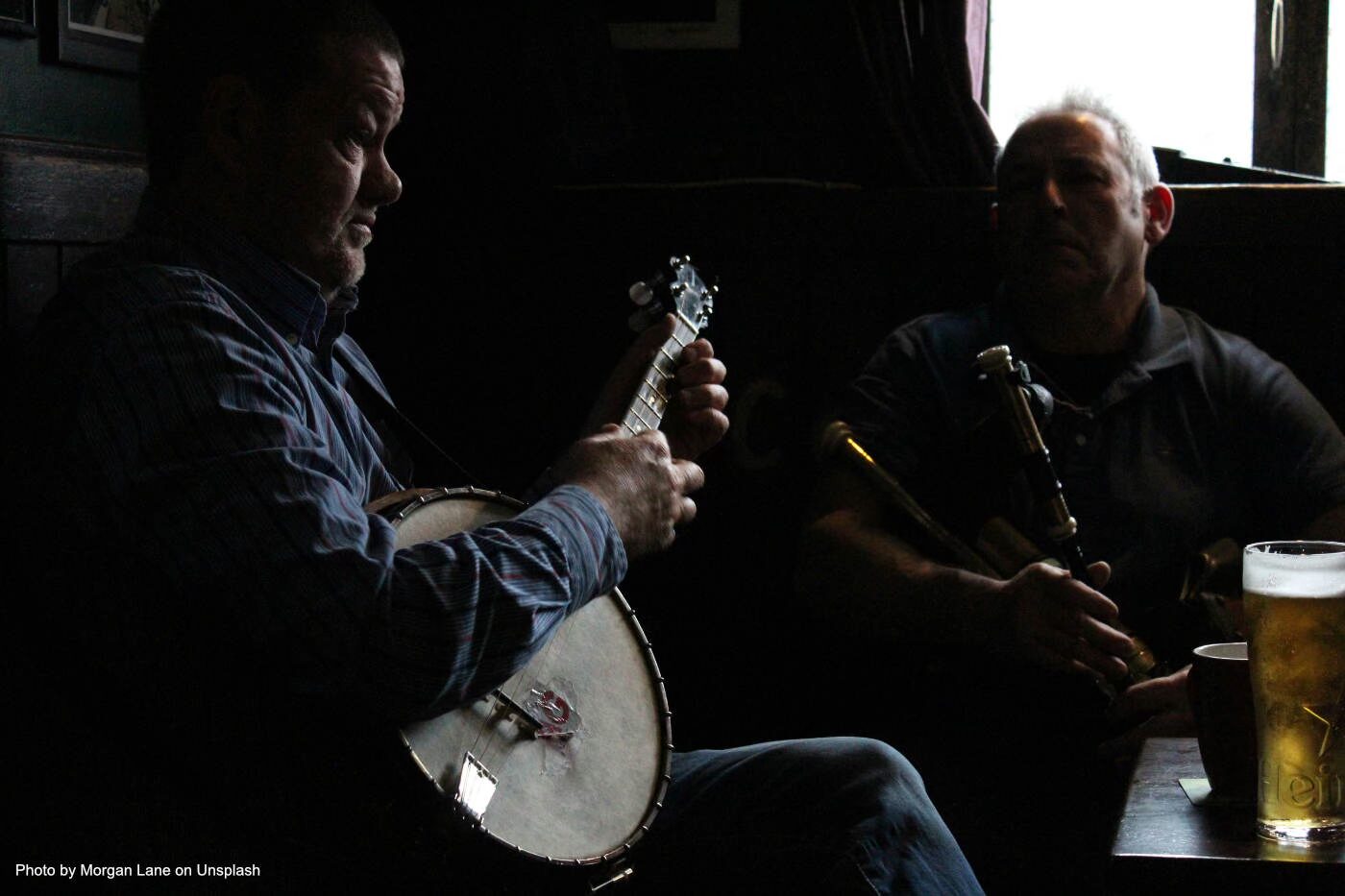
Ireland’s culture is as rich and diverse as its landscapes. To truly connect with the heart of the Emerald Isle, make time for these meaningful experiences during your 3-day trip.
Attend a Traditional Music Session (Seisiún)
A traditional music session is a highlight of any 3 days in Ireland. These gatherings are informal performances where local musicians play folk tunes using instruments like fiddles, bodhráns, and tin whistles. The energy is contagious, and you’ll quickly find yourself tapping your feet to lively jigs or humming along to soulful ballads.
In Dublin, head to iconic spots like O’Donoghue’s Bar, where traditional music has been played for decades. Smaller towns like Doolin in County Clare are also renowned for their vibrant music scene. Many pubs don’t charge an entrance fee for seisiúns, making them accessible to all travelers.
Beyond the music, these sessions are an opportunity to experience Ireland’s legendary hospitality. Strike up a conversation with locals or fellow travelers, and you’ll likely hear stories that enrich your trip even further.
Explore Ancient Sites Like Newgrange or the Rock of Cashel
Ireland’s history stretches back thousands of years, and its ancient sites are a testament to its deep-rooted heritage. Newgrange, a prehistoric passage tomb older than the pyramids of Egypt, is a marvel of engineering and astronomy. During the winter solstice, sunlight perfectly illuminates its inner chamber, demonstrating the advanced understanding of its Neolithic builders.
The Rock of Cashel is another iconic site that shouldn’t be missed. Perched atop a hill in County Tipperary, this collection of medieval buildings includes a round tower, a cathedral, and a chapel. The panoramic views of the surrounding countryside are worth the visit alone.
Both sites provide guided tours that delve into their historical and cultural significance. Make sure to book your tickets in advance, as these attractions can be popular, especially during peak travel seasons.
Learn a Few Gaelic Phrases
While English is the primary language spoken in Ireland, Gaelic (or Irish) remains an important part of the nation’s identity. Learning a few basic phrases can add a special layer to your trip and show locals that you appreciate their culture. Start with greetings like “Dia dhuit” (Hello) or expressions like “Sláinte” (Cheers), often used when raising a glass.
Many museums and cultural centers offer short introductions to Gaelic, which are perfect for travelers. For instance, the Gaelic Language Museum in Dublin provides interactive exhibits that make learning fun. You’ll also notice road signs, place names, and even pub names written in Gaelic, giving you plenty of opportunities to practice.
Even a small effort to use these phrases can spark conversations and smiles from locals. It’s a simple yet impactful way to engage with Ireland’s living heritage.
Dive Into Storytelling Traditions
Ireland is known as the land of storytellers, and its oral traditions date back centuries. You can experience this rich history through performances at pubs, theaters, or dedicated storytelling events. These stories often feature mythical figures like Cú Chulainn or tales of fairies and banshees, offering a glimpse into Ireland’s folklore.
In Dublin, check out storytelling evenings at venues like The Storyteller’s Chair, where talented performers weave magic through their words. In the countryside, some pubs host storytelling sessions alongside live music, creating a truly immersive cultural experience.
Ireland’s stories often connect to its landscapes, making them even more meaningful when paired with visits to places like Glendalough or the Burren, where legends come alive. By the end of your trip, you’ll likely have your own story to tell about Ireland’s enchanting spirit.
Participate in Local Festivals or Events
If your visit coincides with a local festival, you’re in for a treat. Ireland hosts numerous celebrations throughout the year, ranging from music and arts festivals to historical reenactments and food fairs. These events are a vibrant showcase of Irish culture and provide opportunities to connect with locals.
For example, the Galway International Arts Festival features world-class performances in music, theater, and visual arts. Smaller towns often host traditional fairs, like the Puck Fair in Killorglin, where a goat is crowned king in a quirky and historic tradition.
Many festivals also include family-friendly activities, making them ideal for travelers of all ages. Check local event calendars ahead of your trip to see what’s happening during your stay. The AI Ireland Itinerary Creator can help identify events that align with your travel dates and interests, ensuring you don’t miss out on these unforgettable experiences.
Transportation Options During a Short Visit
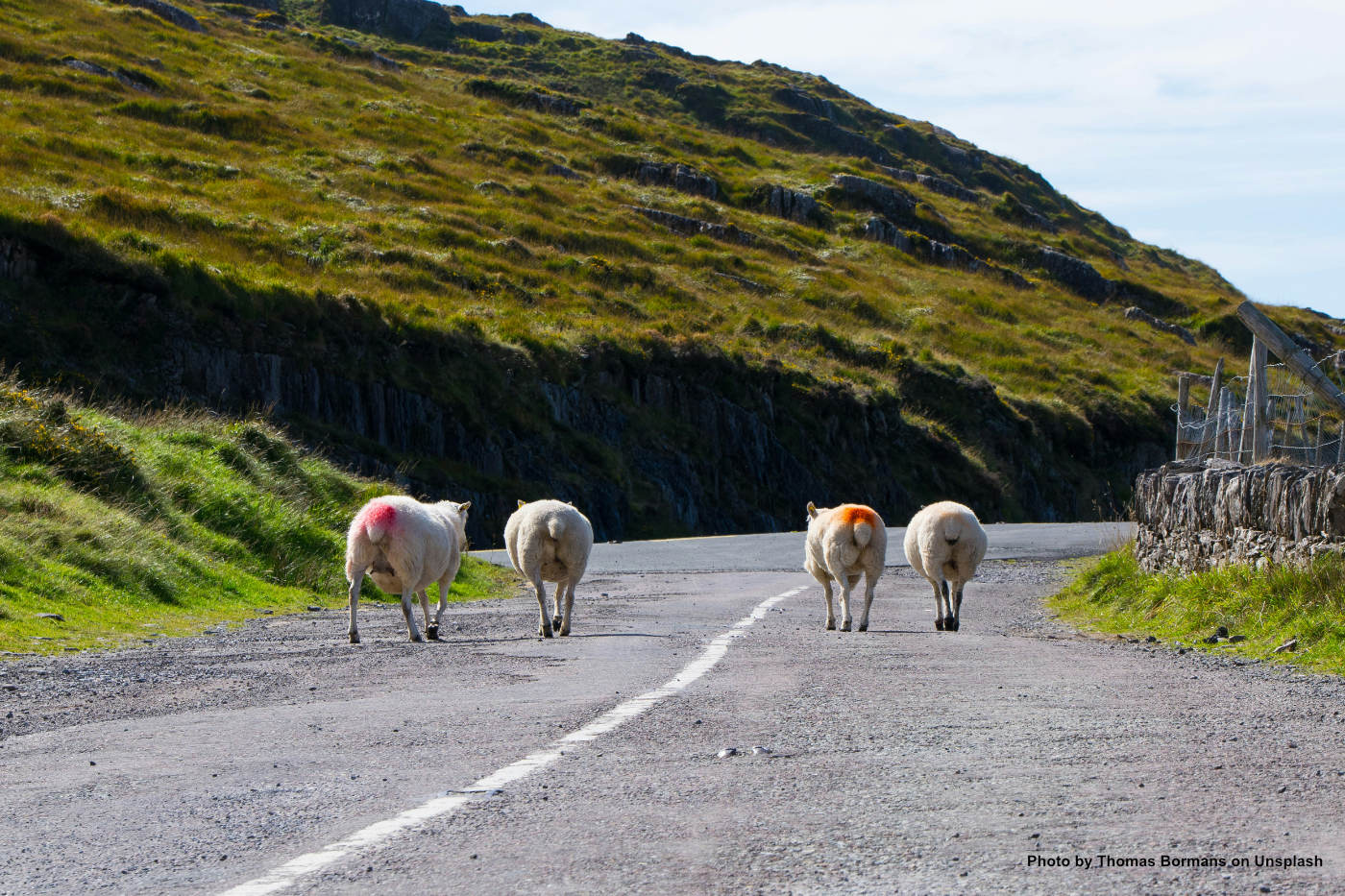
Getting around Ireland efficiently is key to maximizing your 3-day trip. Whether you’re planning to explore cities, venture into the countryside, or drive along the Wild Atlantic Way, understanding your transportation options will make your journey smoother.
Pros and Cons of Renting a Car
Renting a car is often the best choice for travelers who want flexibility and the ability to explore Ireland’s rural landscapes. With your own vehicle, you can easily visit off-the-beaten-path destinations like the Wicklow Mountains, Doolin, or the scenic Ring of Kerry at your own pace. A car also saves time when traveling between smaller towns where public transportation options may be limited.
However, driving in Ireland comes with challenges. Roads in rural areas can be narrow and winding, and driving is on the left side, which may take some adjustment for travelers from the U.S. or mainland Europe. Parking in cities like Dublin can also be expensive and hard to find.
If you decide to rent a car, book early to secure the best rates, especially during peak travel seasons. Opt for a smaller vehicle to navigate Ireland’s narrow roads more easily, and consider adding full insurance for peace of mind.
Navigating Ireland’s Train and Bus Networks
Public transport is a viable option for your 3 days in Ireland. For those who prefer not to drive, Ireland’s train and bus systems are reliable and affordable options. Irish Rail operates trains connecting major cities like Dublin, Cork, and Galway, offering a comfortable and scenic way to travel between urban centers. The journey from Dublin to Galway, for instance, takes about 2.5 hours and offers stunning views of the countryside.
Bus services, such as Bus Éireann, and private operators like Citylink provide extensive coverage to smaller towns and popular attractions. They’re particularly useful for day trips, such as visiting the Cliffs of Moher from Galway or Kilkenny from Dublin. Many buses are equipped with free Wi-Fi and comfortable seating, making them a convenient choice for budget-conscious travelers.
When using public transport, check schedules in advance as services can be less frequent on weekends or holidays. Booking tickets online is often cheaper and ensures your spot on popular routes.
Tips for City Navigation
Ireland’s cities are generally compact and easy to navigate, making walking the best way to explore. Dublin, for example, has several self-guided walking tours that take you through landmarks like Trinity College, Temple Bar, and Dublin Castle. For a more curated experience, join a guided tour to learn about the city’s history and hidden gems.
Cycling is another great option in cities like Galway, where bike rentals are readily available. The Salthill Promenade is particularly popular for cyclists, offering beautiful views of Galway Bay.
Public transportation within cities is also efficient. Dublin’s LUAS tram system and buses provide affordable ways to move between neighborhoods. Consider purchasing a Leap Card, which works on buses, trams, and trains and offers discounted fares.
Planning for Scenic Drives
Ireland is famous for its scenic driving routes, and even if you’re not renting a car for your entire trip, it’s worth considering for a day. The Wild Atlantic Way, stretching along the west coast, offers breathtaking views of cliffs, beaches, and charming villages. Another favorite is the Causeway Coastal Route in Northern Ireland, which includes highlights like the Giant’s Causeway and Carrick-a-Rede Rope Bridge.
If you’re nervous about driving yourself, look into private driver tours or small group tours that cover these iconic routes. These options allow you to enjoy the scenery without the stress of navigating unfamiliar roads.
Make sure to plan rest stops along the way, as Ireland’s many roadside cafes and viewpoints are worth savoring. Always allow extra time for unexpected delays or photo opportunities—you’ll likely find it hard to resist stopping for that perfect view!
Choosing Accommodations Based on Transport Access
Where you stay can significantly impact your transportation choices. If you’re relying on public transport, choose accommodations near train stations or bus terminals. In Dublin, staying in the city center means most attractions are within walking distance or a short tram ride away.
In smaller towns like Kilkenny or Galway, look for centrally located guesthouses or hotels to minimize travel time. Many rural B&Bs also offer helpful advice about local transport options, including taxi services or nearby bus stops.
If you are renting a car, ensure your accommodations have parking facilities, as street parking in cities can be limited and expensive. Some countryside hotels and inns even offer free parking, making them ideal for road trip stops.
Accommodation for 3 Days in Ireland
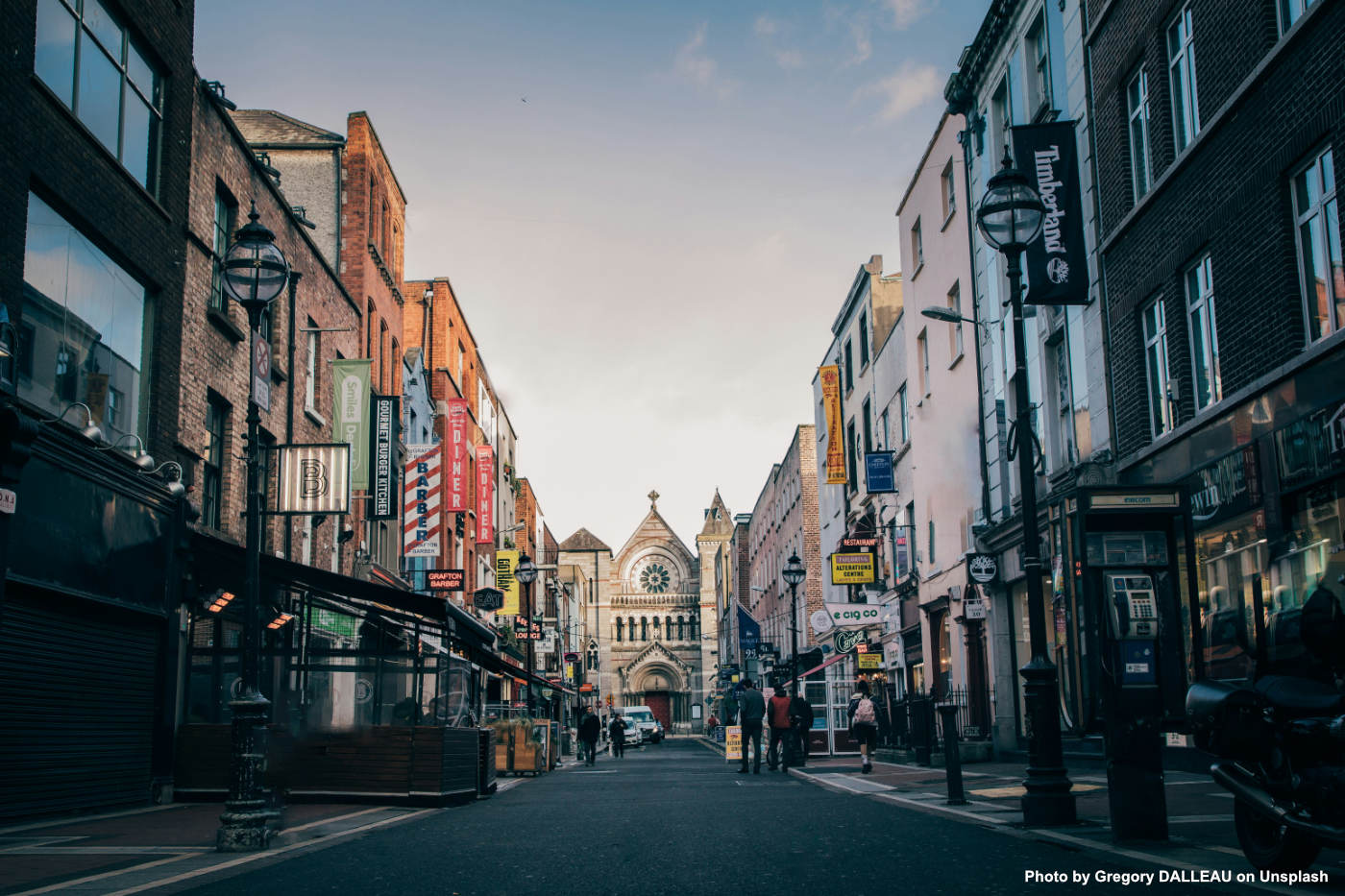
Where you stay during your 3-day trip to Ireland can significantly influence your experience. From charming B&Bs to luxurious castle hotels, Ireland offers a wide range of accommodations to suit every preference and budget.
Choosing Between Hotels, B&Bs, and Self-Catering Cottages
Hotels are a convenient option, especially in cities like Dublin and Galway, where you’ll find a variety of choices ranging from budget-friendly chains to upscale boutique hotels. Staying in a centrally located hotel means you’ll be within walking distance of key attractions, saving precious travel time.
Bed and Breakfasts (B&Bs) are a quintessentially Irish experience. These family-run establishments offer cozy accommodations, personalized service, and a hearty Irish breakfast to start your day. Many B&B hosts are eager to share local tips and stories, adding an authentic touch to your visit.
For those seeking a home-away-from-home vibe, self-catering cottages or vacation rentals are ideal. These options are particularly popular in rural areas, providing privacy and the opportunity to cook your own meals. They’re a great choice for families or travelers who want a more independent stay.
Best Accommodations in Dublin, Galway, and Cork
Staying in the city center is key to maximizing your short visit to Dublin. Hotels like The Westbury offer luxury and are close to landmarks like Grafton Street and Trinity College. For a more budget-friendly option, consider Jurys Inn Parnell Street, which is close to major attractions.
Galway’s vibrant atmosphere makes it a favorite among travelers. The Galway Bay Hotel offers stunning views of the Salthill Promenade, while The House Hotel in the Latin Quarter places you in the heart of the city’s arts and culture scene. Both options combine comfort with excellent locations.
Cork is known for its culinary delights, and staying near the city center ensures easy access to the English Market and historic sites. The Imperial Hotel Cork is a standout choice for luxury, while The Montenotte Hotel provides boutique charm with panoramic views of the city.
Unique Stays: Castle Hotels and Rural Retreats
For a truly unforgettable experience, consider staying in a castle hotel. Properties like Ashford Castle in County Mayo or Dromoland Castle in County Clare combine luxury with history, allowing you to sleep like royalty. These hotels often include fine dining, spa treatments, and activities like falconry or horseback riding.
If you prefer a quieter escape, rural retreats such as The Lodge at Ashford Castle or Ballymaloe House in County Cork provide serene settings surrounded by Ireland’s natural beauty. These locations are perfect for relaxing evenings after a day of exploration.
Unique accommodations like glamping pods or converted lighthouses are also available, offering quirky yet comfortable alternatives for adventurous travelers. These options are great for those looking to add a distinctive touch to their trip.
Finding Budget-Friendly Yet Authentic Stays
Traveling on a budget doesn’t mean sacrificing authenticity or comfort. Hostels like Barnacles Hostel in Galway or Generator Hostel in Dublin provide affordable lodging with a social atmosphere, making them ideal for solo travelers or those looking to meet like-minded adventurers.
Budget-friendly hotels like Maldron Hotels or Travelodge offer clean and comfortable rooms with convenient locations. Many also include breakfast, saving you time and money in the mornings.
For a more local experience, consider staying in guesthouses or smaller inns. These accommodations often have competitive rates and provide the warmth and hospitality Ireland is known for. Websites like Airbnb or Booking.com can help you find excellent deals tailored to your preferences.
The Importance of Booking in Advance
Booking accommodations ahead of time is crucial, especially during peak travel seasons like summer or major events such as St. Patrick’s Day or the Galway Races. Popular destinations like Dublin, Galway, and Killarney can fill up quickly, leaving fewer choices and higher prices for last-minute bookings.
Planning ahead also gives you access to early-bird discounts and ensures that you secure the type of lodging that suits your needs. The AI Ireland Travel Expert is a helpful tool for identifying and reserving accommodations that fit seamlessly into your travel plans, whether you’re looking for luxury or budget options.
Remember to check cancellation policies when booking, as flexibility is always helpful in case of changes to your itinerary. With a bit of planning, you can rest assured that your stay in Ireland will be comfortable and stress-free.
Food and Drink Recommendations

Savoring local cuisine is essential to fully experience your 3 days in Ireland. Ireland’s culinary scene is a treat for the senses, combining hearty traditional dishes with innovative modern cuisine. From cozy pubs to fine dining establishments, there’s no shortage of delicious food and drink to enjoy during your 3 days in Ireland.
Classic Irish Dishes You Must Try
Ireland’s traditional dishes reflect its history and natural resources. One of the most iconic meals is Irish stew, made with tender lamb or beef, potatoes, carrots, and onions. It’s the ultimate comfort food, especially on a cool day. Many pubs across the country, such as The Brazen Head in Dublin, serve excellent versions of this classic dish.
Another must-try is boxty, a potato pancake that’s crispy on the outside and soft on the inside. It’s often served with smoked salmon or creamy sauces, making it a versatile dish perfect for any time of day. Seafood lovers will appreciate Ireland’s seafood chowder, a creamy soup filled with fresh fish, mussels, and prawns, usually accompanied by hearty brown soda bread.
For a quick bite, try bacon and cabbage, a simple yet flavorful dish that’s a staple of Irish home cooking. And don’t forget to indulge in sweet treats like Baileys cheesecake or fresh scones with jam and cream, often served in local tearooms.
Best Pubs for a Pint and Live Music
Every trip to Ireland is complete with a visit to its legendary pubs, which serve as social hubs and cultural landmarks. In Dublin, The Temple Bar is a lively spot known for its extensive whiskey collection and nightly live music sessions. For a more traditional vibe, head to O’Donoghue’s Bar, where legendary Irish musicians like The Dubliners once performed.
Galway is another fantastic city for pub culture. Tigh Neachtain, located in the heart of the Latin Quarter, offers a cozy atmosphere, an excellent selection of craft beers, and live music that captures the spirit of the West. Monroe’s Tavern, also in Galway, is famous for its energetic atmosphere and traditional Irish dancing nights.
Pubs aren’t just about the drinks—they’re also great places to try local food. Order a pint of Guinness or a glass of Smithwick’s ale to pair with your meal and soak up the friendly, welcoming atmosphere.
Iconic Drinks: Guinness, Irish Whiskey, and Craft Ciders
Ireland is synonymous with Guinness, the world-famous stout with its distinctive creamy head. A visit to the Guinness Storehouse in Dublin is a must for fans, where you can learn about the brewing process and enjoy a perfectly poured pint at the Gravity Bar.
Ireland offers a rich tradition of distilling for whiskey enthusiasts. Take a tour of the Jameson Distillery in Dublin or the Old Bushmills Distillery in Northern Ireland to learn about the craft behind this iconic spirit. Sampling a flight of different whiskeys is a great way to explore the variety of flavors Irish distilleries have to offer.
Craft cider is another rising star in Ireland’s drink scene. Brands like Orchard Thieves and Stonewell are widely available and offer a refreshing alternative to beer. Many pubs and restaurants now feature locally produced ciders and craft beers, giving you a taste of Ireland’s innovative beverage industry.
Sweet Treats: Irish Cream Desserts and Scones
Ireland’s desserts are as comforting as its main dishes. Irish cream desserts, often made with Baileys, combine rich, creamy textures with a hint of whiskey flavor. From cheesecakes to mousses, these desserts are a decadent way to end a meal.
Freshly baked scones, served warm with jam and clotted cream, are another highlight. You’ll find them in cafes and tearooms across Ireland, like Queen of Tarts in Dublin, which is renowned for its baked goods and charming atmosphere. Pair your scone with a cup of Irish breakfast tea for the perfect mid-morning treat.
Other sweet specialties include barmbrack, a fruit loaf traditionally served around Halloween, and Carrageen moss pudding, a traditional seaweed-based dessert that’s surprisingly delicious and unique to Ireland.
Farm-to-Table Dining in Rural Areas
Ireland’s countryside is home to some of the best farm-to-table dining experiences. Restaurants like Ballymaloe House in County Cork showcase seasonal, locally sourced ingredients, creating dishes that highlight the region’s agricultural bounty.
Coastal towns like Dingle and Kinsale are also known for their focus on fresh seafood and artisan products. In Kinsale, often called the “Gourmet Capital of Ireland,” you’ll find everything from Michelin-starred restaurants to quaint cafes offering dishes crafted from freshly caught fish and locally grown vegetables.
Farmers’ markets are another way to experience Ireland’s vibrant food culture. Markets like Galway’s St. Nicholas Market or Dublin’s Temple Bar Food Market are perfect for picking up fresh produce, baked goods, and unique artisan products to enjoy during your trip.
Wrapping Up Your 3 Days in Ireland

Your 3 days in Ireland may feel short, but with the right planning, it’s enough to experience the country’s vibrant culture, stunning landscapes, and warm hospitality. As your trip draws to a close, here’s how to make the most of your departure and reflect on your journey.
Planning a Smooth Departure (Airport Tips)
If you’re flying out of Dublin Airport, aim to arrive at least three hours before your flight, especially if traveling internationally. The airport can get busy, and security lines can be long during peak hours. Take advantage of the airport’s pre-clearance for U.S. Customs, which allows you to complete immigration formalities before boarding, saving time upon arrival in the United States.
For those departing from Shannon Airport, enjoy a less hectic experience. This smaller airport also offers pre-clearance for U.S. passengers and a relaxing atmosphere, making it a preferred choice for many travelers heading back to the States.
Before leaving, take some time to browse the airport’s shops. Pick up last-minute souvenirs like Irish chocolates, whiskey, or woolen goods to remember your trip. Duty-free stores at Dublin and Shannon airports often carry high-quality Irish products, perfect for gifts or keepsakes.
Reflecting on the Highlights of Your Trip
As you head home, take a moment to think about the most memorable parts of your 3-day adventure. Perhaps it was the breathtaking views of the Cliffs of Moher, the lively music sessions in Galway’s pubs, or the historical treasures of Dublin’s Trinity College. Each highlight represents a piece of Ireland’s unique charm, offering stories and experiences to share with friends and family.
Many travelers find that their brief visit leaves them eager to return. Whether it’s exploring more of the Wild Atlantic Way, visiting Northern Ireland’s Giant’s Causeway, or attending a local festival, Ireland has a way of capturing hearts and inspiring future journeys.
Bringing Home Memories: Top Souvenirs to Buy
Ireland is known for its craftsmanship, so bring home something special to remember your trip. Aran sweaters are a timeless choice, offering warmth and a connection to Ireland’s traditions. Look for authentic sweaters made from 100% wool in places like the Aran Islands or Dublin’s specialty shops.
Other great souvenirs include Claddagh rings, symbolizing love, loyalty, and friendship, or hand-blown glassware from artisans like Waterford Crystal. Food lovers can stock up on Irish jams, cheeses, or whiskey-infused chocolates, which make delightful gifts.
For something more personal, consider purchasing a book of Irish poetry or a print from a local artist. These keepsakes serve as lasting reminders of your time in the Emerald Isle.
How the AI Ireland Itinerary Creator Enhances Your Experience
The AI Ireland Travel Expert is an invaluable tool for planning a seamless and memorable trip. It takes the guesswork out of organizing your 3 days in Ireland, offering tailored recommendations for attractions, accommodations, and dining options. With its user-friendly interface, you can create an itinerary that fits your preferences and ensures you make the most of your time.
By incorporating local insights and practical tips, the tool helps streamline your travel plans, leaving you free to enjoy the magic of Ireland without worrying about logistics. If you’re already dreaming of a return visit, the AI Ireland Itinerary Creator can help you explore even more of what this beautiful country has to offer.
Tips for Extending Your Next Visit
If you’re already planning to come back, consider extending your next trip to see the parts of Ireland you missed. Spend time in Northern Ireland, where attractions like the Giant’s Causeway, Carrick-a-Rede Rope Bridge, and Titanic Belfast await.
The south and southwest regions, including Killarney National Park and the Dingle Peninsula, offer breathtaking landscapes and a slower pace of life. These areas are perfect for road trips, with plenty of opportunities to stop at quaint villages and scenic viewpoints.
Ireland also has a vibrant festival calendar, so plan your next visit around events like the Galway Races, Cork Jazz Festival, or St. Patrick’s Day celebrations. These experiences will give you a deeper appreciation of Ireland’s lively spirit and cultural heritage.
A trip to Ireland in just three days might feel short, but with the right planning, it can be an unforgettable experience. From exploring Dublin’s historic streets to marveling at the Cliffs of Moher and savoring hearty Irish dishes in cozy pubs, your 3 days in Ireland will be packed with adventure, culture, and cherished memories.
Ireland’s compact size makes it ideal for short trips, offering the chance to experience its diverse landscapes and vibrant cities without spending too much time traveling. Each moment—whether spent enjoying live music in Galway, exploring the ancient ruins of Newgrange, or walking through the lush Wicklow Mountains—gives you a glimpse into the heart of what makes Ireland so special.
To maximize your time and ensure you don’t miss the highlights, tools like the AI Ireland Travel Expert are invaluable. This innovative platform takes the stress out of planning by tailoring an itinerary to your preferences, balancing iconic landmarks with hidden gems. It’s the perfect companion to make every moment of your trip count.
As you reflect on your 3 days in Ireland, you’ll likely plan a return visit. There’s so much more to explore—from Northern Ireland’s Giant’s Causeway to the peaceful beauty of the Dingle Peninsula. Each trip offers a new opportunity to connect with Ireland’s warm hospitality, rich traditions, and awe-inspiring scenery.
Whether you’re planning a family trip, a romantic getaway, or a solo adventure, the hub is packed with ideas to make your Irish experience unforgettable. Additionally, if you have more time, visit our multi-day itinerary hub.
So pack your bags and get ready to experience the Emerald Isle, even if only for a few days. Your 3 days in Ireland will leave you with stories to tell, photos to cherish, and a deep appreciation for the magic of this incredible country. Sláinte!
How to plan: 3 Days in Ireland with AI
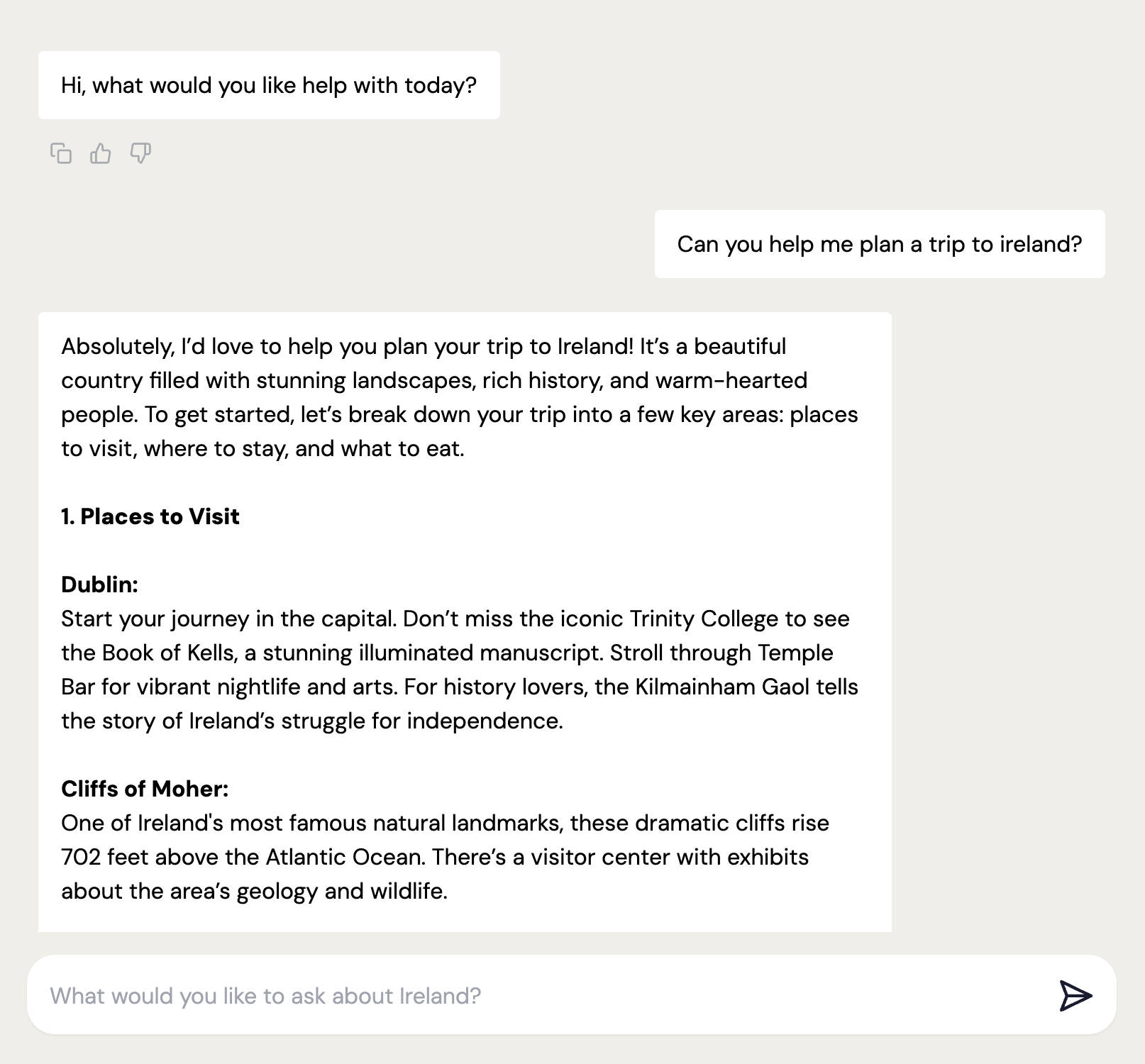
ASK THE AI TRAVEL EXPERT A QUESTION
Now that you are on the prompt screen, go ahead and ask the AI Ireland Travel Expert a question about Ireland that you need help with. Example: 'Plan for me: 3 Days in Ireland'.

RINSE & REPEAT
Now go ahead and ask the Expert any further questions or refine the answers you've been given. Next step: Travel to Ireland!
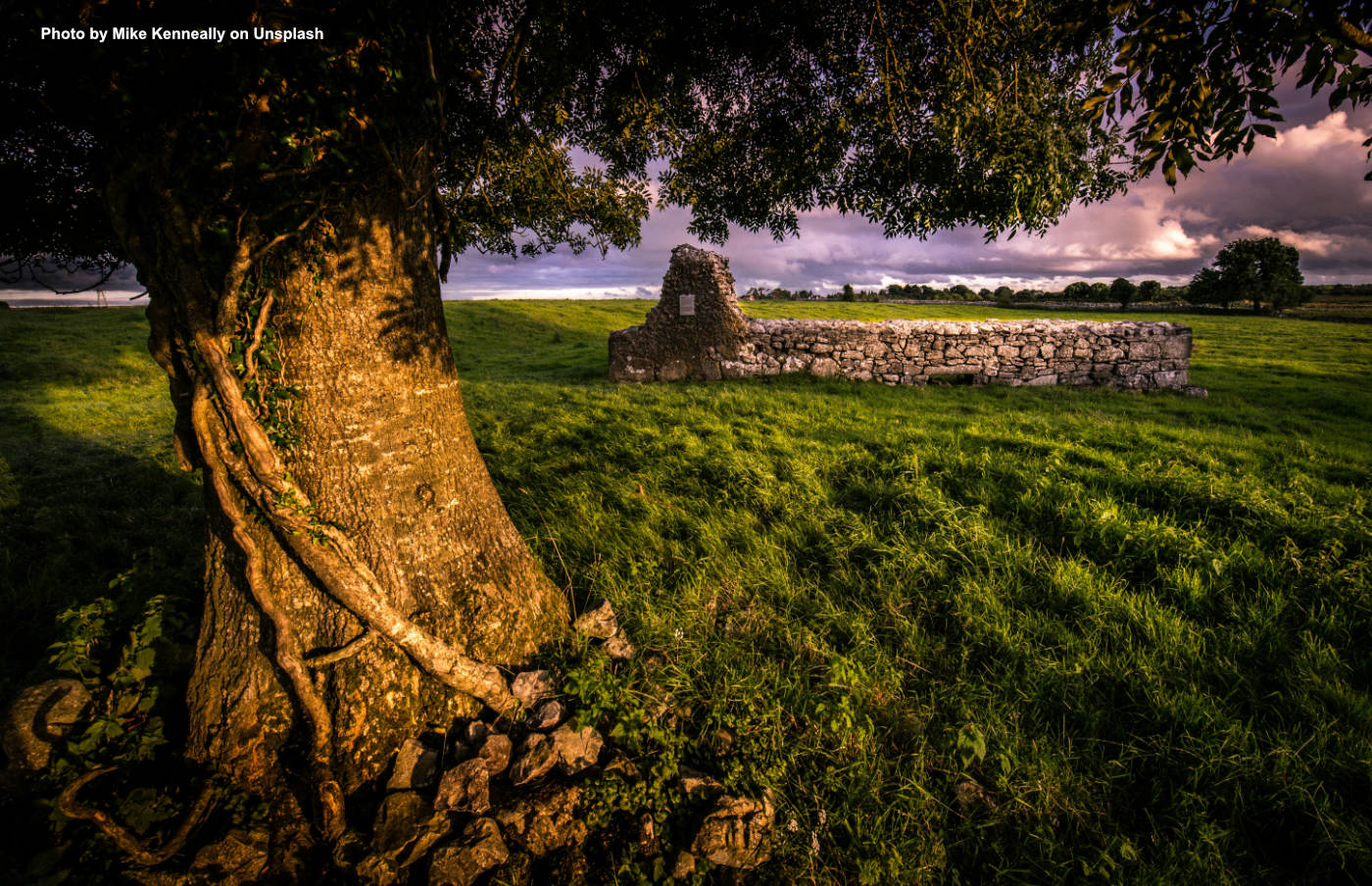
Did you know this article was created with the AI Ireland Travel Expert?
Imagine this: lush green landscapes, centuries-old castles, and the friendliest locals you’ll ever meet—all packed into three magical days.
Whether you’re tight on time or want a taste of what Ireland has to offer, a 3 Days in Ireland is the perfect way to experience the highlights.
With a little planning (and a bit of help from technology), you can weave through Ireland’s history, natural beauty, and lively culture in just 72 hours.
This itinerary was created with the AI Ireland Travel Expert and it can be your personal travel assistant, helping you organize routes, manage timings, and make the most of your short stay.
It’s the perfect tool to maximize efficiency while still leaving room for spontaneity.
Whether you’re traveling solo, with friends, or as a family, these plans ensures you’ll have a fantastic Irish adventure, leaving you both satisfied and craving more.
If you can make additional time for more or plan to return to ireland, check out the Ireland Itinerary Hub which has lots of itineraries to maximise your vacation time in Ireland.
FAQ
>> What are the must-see attractions in Ireland for 3 days in Ireland?
In just three days, focus on highlights like Dublin’s historic sites, the scenic beauty of the Wicklow Mountains, and the vibrant culture of Galway. These itineraries offer a balanced mix of urban and rural experiences.
>> How can I efficiently travel between destinations in Ireland?
Ireland’s compact size makes it easy to navigate. Utilize trains and buses for intercity travel, or consider renting a car for more flexibility, especially when exploring rural areas.
>> What should I pack for 3 days in Ireland?
Given Ireland’s variable weather, pack layers, waterproof clothing, and comfortable walking shoes. An umbrella and a light jacket are also advisable.
>> Is it necessary to book accommodation and tours in advance?
During peak tourist seasons, it’s recommended to book accommodations and popular tours ahead of time to ensure availability and secure better rates.
>> What local foods should I try during my visit?
Don’t miss traditional dishes like Irish stew, soda bread, and seafood chowder. Visiting local pubs offers an authentic dining experience with live music and a friendly atmosphere.
>> Are there any itineraries for more than 3 days?
Yes! Visit our multi-day itinerary hub.

